VOLKSWAGEN JETTA 2009 Owners Manual
Manufacturer: VOLKSWAGEN, Model Year: 2009, Model line: JETTA, Model: VOLKSWAGEN JETTA 2009Pages: 477, PDF Size: 77.6 MB
Page 131 of 477
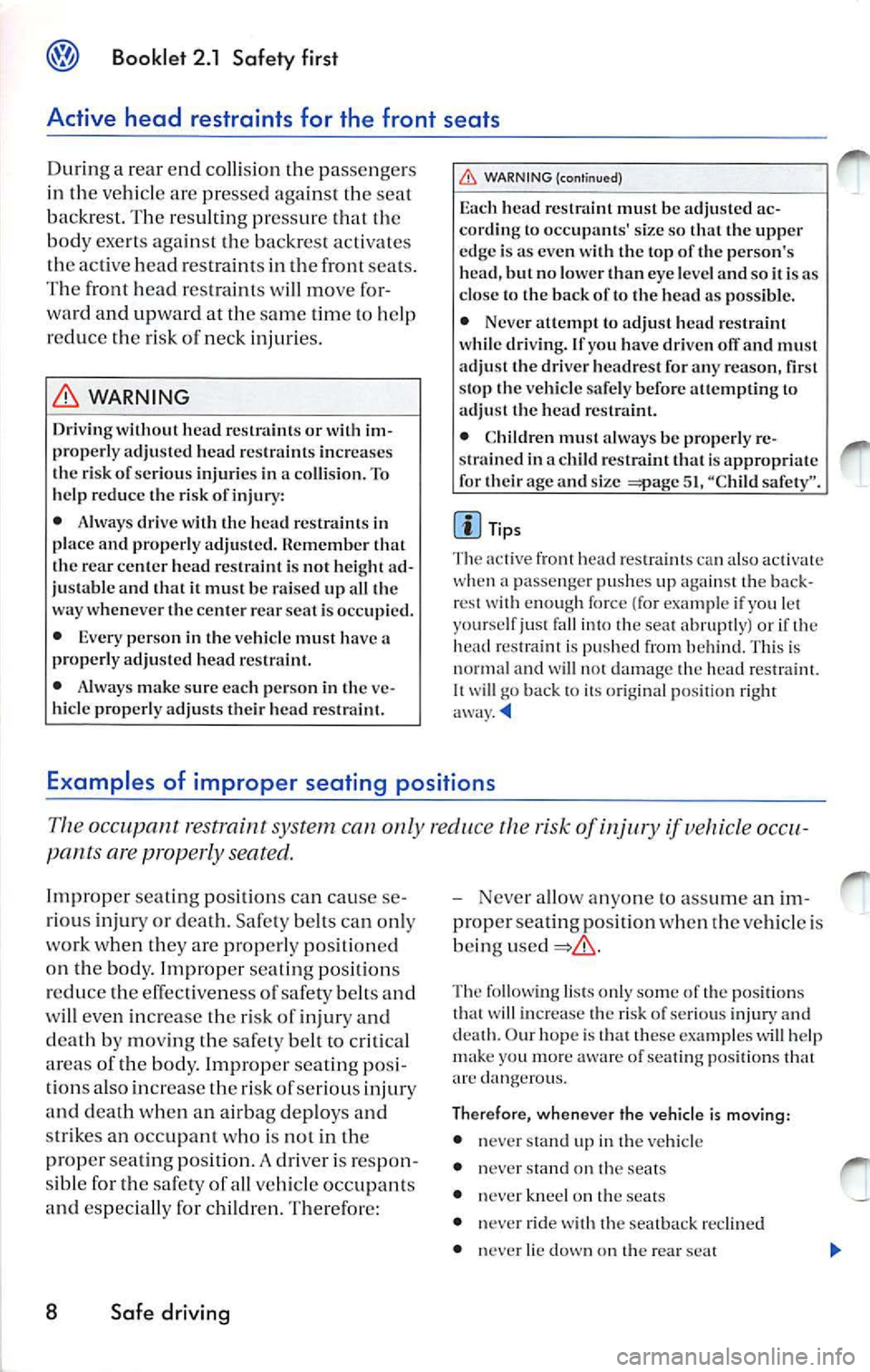
Booklet 2.1 Safety first
Active head restraints for the front seats
During a rea r e nd collisio n the passenge rs
in th e vehicle are pressed against th e sea t
back rest. The res ultin g pressu re th at the
body exe rts aga in st th e bac kres t ac tivates
t h e ac tive head rest raint s in the front seats .
Th e front hea d res train ts wi ll mo ve fo r
w ard and upwa rd at the sa me tim e to help
r e duce the risk o f n eck injuri es.
WARNING
Driving without hea d re stra ints or with im
properl y ad justed head r estraint s in creases
th e risk or seriou s injuri es in a collision . To
help reduce th e risk or injury:
• Always drive
th e hea d r estra ints in
place and prop erl y a dju sted. Remember that
th e rear center he ad r estraint is not h eight ad
ju stabl e and that it mu st be rai sed up all th e
w ay w hen eve r the center rear seat is occ upied .
• Every per son in the vehicle must have a
properly adjuste d head restraint.
• Always make su re each perso n in the ve
hicl e prop erl y adju sts th eir head r estraint.
WA RNING (continue d)
Eac h head restraint mu st be adju ste d ac
cord ing to oc cupants ' size so that the upper
edge is as eve n with the top or the person' s
h ead, but no lo wer than eye level and so it is as
clo se to th e back or to the h ead as possibl e.
• Nev er attempt to adjust head res traint
whil e dri vin g. Ir you have driven
and must
adju st the driver h eadr est any reaso n, stop the vehicl e attempting to
adju st the hea d re straint.
• Children mu st always b e properl y re
strained in a c hild restraint that is appropriat e
their age a nd size 5 1, " C hild
Tips
The acti ve head res train ts ca n also ac tivate
w hen p assenger push es up agains t th e ba ck
r es t wi th en ough force exa mpl e yourse lf ju st into th e seat abr uptly) or if th e
h ea d res train t is push ed from behind. This is
n orm al and will not da m age th e head res traint.
I t w ill go back t o its o riginal pos itio n rig h t
Examples of improper seating positions
The occupant rest raint system ca n on ly redu ce th e risk of if v eh icle
pa nts ar e prop erly sea ted .
Improp er se atin g po siti ons ca n cause se
r io us injur y or deat h. Safe ty belts ca n on ly
wo rk whe n th ey are prop erl y pos ition ed
o n th e body . Impr oper seati ng posit ions
r e du ce the e ffect ive ne ss of sa fe ty belt s a nd
w ill eve n inc rease the ris k or injury and
d ea th by m ov ing t he sa fety belt to criti cal
a reas of the body. Imp roper seating posi
ti ons a ls o in crease the risk of seriou s injur y
and d eath when a n airb ag de plo ys and
s trikes an occ upant who is not in the
prop er sea ting po sition.
driver is res pon
s ibl e for the sa fe ty of all vehicl e occ upant s
a nd especiall y for childr en. There for e:
8 Safe driving
-Never a llow anyone to ass um e an im
proper seating pos it ion when th e ve hicl e is
bei ng
lists onl y so me or the pos itions
that will increase the risk or ser io us injury and
d ea th. Our h ope is
th ese ex amples will help
mak e you more awa re of sea ting po siti ons that
ar e da ngero us.
Therefore, whenever the vehic le is moving:
• neve r sta nd up in the vehicle
• neve r stand on the seats
• neve r kneel on th e seats
• neve r rid e with the seat back recl ined
• never lie clown on th e re ar sea t
Page 132 of 477
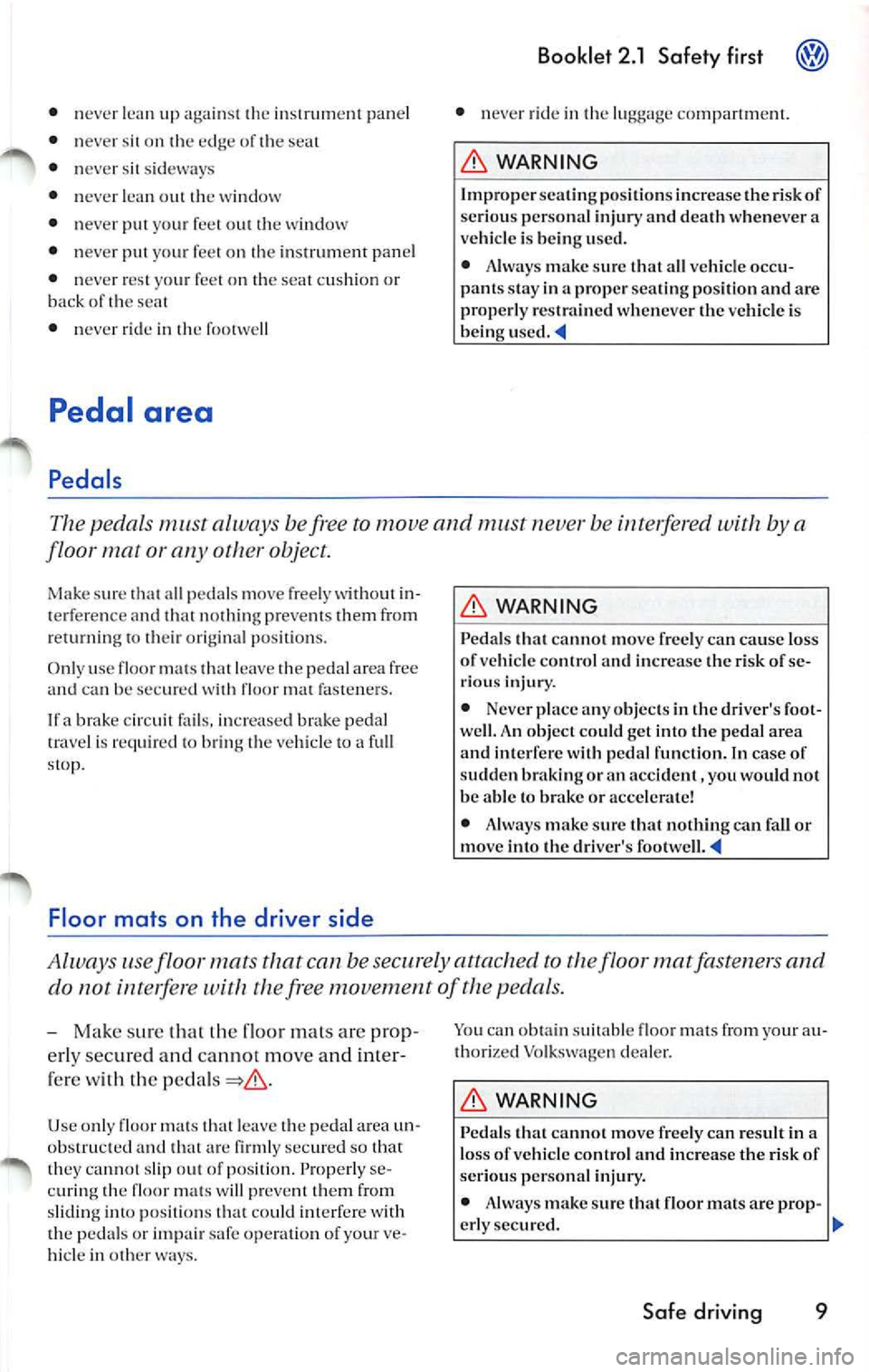
• never up again st th e in strument panel
• neve r sit on the ed ge of t he sea t
• never sit sideway s
• neve r lean out the wi ndow
• never put your feet o ut the w indow
• never put your fee t o n th e in strument panel
• never rest yo ur f eet on the
cu shi on or
back of the se at
• never rid e in th e footwe ll
Pedal area
Pedals
Booklet 2 .1 Safety first
• never ride in th e lu ggage comp artment.
WARNING
Improper seating position s in crease the risk of
se rious personal injury and death whenever a
ve hicle is bein g used.
• Alway s mak e sure that all vehicl e occu
pant s stay in a proper seat ing position and arc
properly re strained wheneve r the vehicl e is
be ing used
The pedals must always be free to move and mu st neve r be inte1f ered with by a
floor mat or any other object .
Make sure that a ll pedals move freel y w ith out in
t e rf er enc e and that nothing pre vents them from
r e turnin g to th eir orig inal po siti ons.
Onl y use floo r mat s th at l eav e the pedal area free
a nti can
sec ured with floor faste n ers.
l fa brak e cir cuit fai ls, in cre ase d brake pedal
t ra ve l is re qu ire d to b ring th e ve hicle to a full
Floor mats on the driver side
WARNING
Pedal s that cannot mov e fre ely can cause loss
of vehicle contro l a nd increase the risk of se
riou s inj ury.
• Neve r p lace any ob jects in the driver' s foot
we ll. An object cou ld get into the pedal area
and interfe re wit h pedal function. In case o f
s udden braking or an accident, you wo uld not
be abl e to brake or accelera te!
• Always make sure that nothing can fa ll or
mov e into the d river's foo t we ll.
Always floor mats that can be securely attached to floor mat fasteners and
do not int e,f ere
free movement of th e peda ls.
Mak e su re that the floor mat s are prop
e rl y sec ured and can not mo ve and inter
fe re w ith th e
Use onl y flo or m ats that leave the pedal area unand that fi rmly secured so that
th ey ca nnot slip out o f po sition . Prop erly se
c urin g th e floor ma ts w ill pre vent th em from
s lidin g in to po siti ons th at co uld int erf ere wit h
th e pedal s or imp air saf e o perati on of yo ur ve
hicl e in oth er w ays . You
can ob tain suitabl e floo r mat s fro m your au
th orized Volk swa gen dea ler.
WARNING
Peda ls that cannot mo ve freel y can result in a
l oss o f vehicle control and increase the risk of
ser ious pe rs on al in jury.
• Always make sure that floor mats are prop -
erly secured.
Safe driving 9
Page 133 of 477
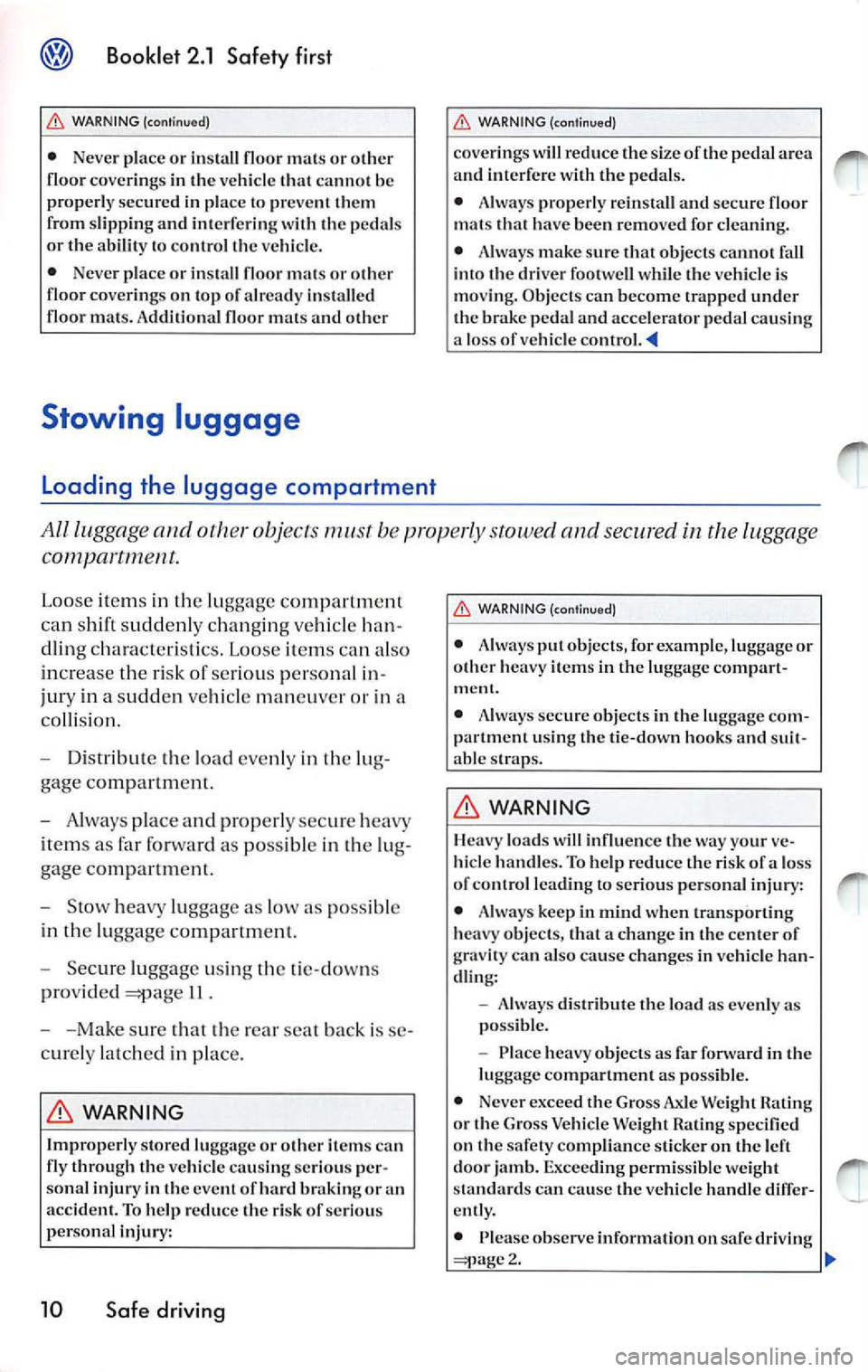
Booklet 2.1 Safety first
WARNING (conlinuod)
• Neve r place or install floor mats or other
floor cover ings in th e vehicle that can n ot be
proper ly secure d in place to prevent them
from slip pin g and
with the pedals
or the abili ty to contro l the vehicle.
• Neve r place or insta ll floor mats or o ther
floor coverings on top of alr eady ins ta ll ed
floor mats. Additiona l floor mat s and oth er
Stowing luggage
Loading the luggage compartment
WARN ING (con tinued)
coverings w ill reduce the size of the pedal area
an d int erf ere with the pedals.
• Always properly reinstall and sec ure floor
ma ts that have been removed for cleaning.
• Always make sure that objects can not fa ll
int o the driver foot well w hile th e vehicle is
moving. Objects ca n become trapped under
th e brake pedal and acce lerator peda l ca using
a loss of vehicl e
All luggag e and object s ,n ust b e prop erly stowed and secured the luggage
compartment.
Loos e item s in th e luggag e compartmen t
c an shi ft sudden ly chang ing vehicle han
dling charact eri stic s. Lo ose item s ca n also
in crea se the ri sk of se ri ous pe rs onal in
j ur y in a sudd en veh icl e m an euv er or in a
co llision.
- Distribute the load evenly in th e lu g
gag e compar tment .
- Alwa ys pla c e and properly sec ure heav y
it em s as far forward a s po ss ibl e in the lug
gage compar tm ent.
- S tow hea vy lugg age as low as possibl e
in the luggag e compar tm ent.
- Secure luggag e usin g th e tic -dow ns
pro vid ed
11 .
- -Ma ke su re that the re ar sea t ba ck is se
cu re ly lat ch ed in pl ace.
WARNING
Improp erl y s tor ed luggage or other items can
fly through the vehicl e cau sing serious per
so nal inju ry in th e event of hard braking or an
accident. To help reduce the risk of se rious
personal injury:
10 Safe driving
WARN ING (continued)
• Always put objects, for examp le, luggage o r
oth er he avy item s in the luggage compa rt-
WARNING
Heavy loads will influ ence the way yo ur ve
hicle handle s. To help reduce the risk of a lo ss
of contro l lea din g to serio us personal injury:
• Alway s keep in mind when t ransporting
h ea vy objects, that a c hange in the ce nter of
grav ity can also ca use c hang es in ve hicle han
d lin g:
- Always distribut e the load as eve nly as
po ss ibl e.
- Place heavy objects as far forward in the
luggage compart ment as poss ible .
• Never excee d the Gross Axle Weig ht Rating
or the Gross Vehicle Weight Rating specified
on the safety complian ce s ticke r on the lef t
door jamb. Exceed ing permissib le we ig ht
s tandards can cause the vehicl e handl e diff er
e ntl y.
• Please observe information on safe driv ing
Page 134 of 477
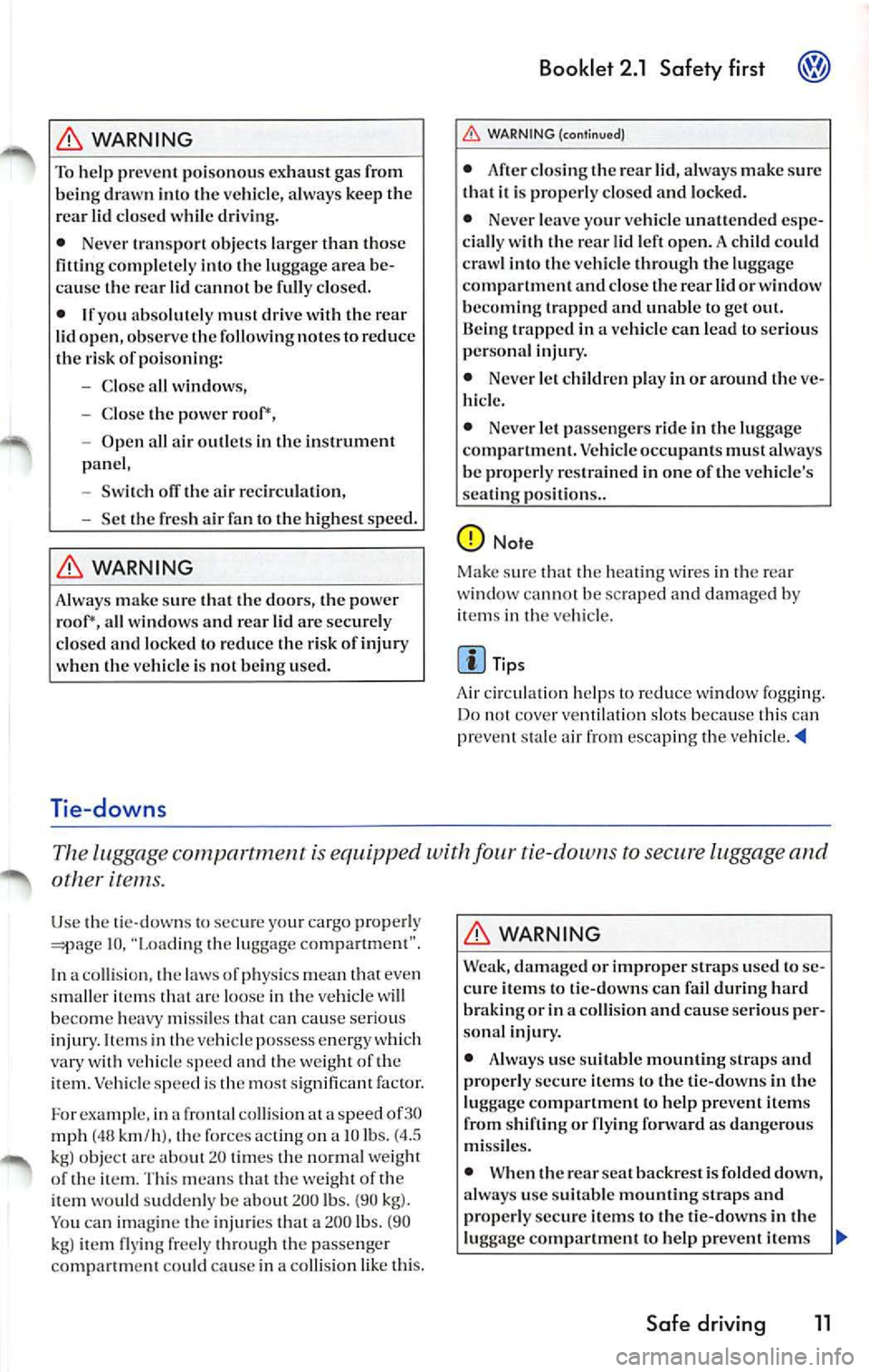
WARNING
To help preven t poiso nous ex haust gas bei ng draw n in to the ve hicle, always kee p th e
r ea r li d closed w hile dri vin g.
• Never tra nspo rt objec ts la rger than those
fill ing co mplete ly i nto
lu ggage area be
ca use re ar lid cann ot be full y close d.
• If you abso lutely m usl d rive
th e rear
li d ope n, obse rve fo llow ing notes to red uce ris k of poiso ning:
C lose a ll win dows,
C lose the power
Ope n all ai r o ut lets i n the instrume nt
panel,
Swi tc h olT air reci rc ul ati on,
Se t th e fr esh air fan lo h ig hes t speed .
WARNING
Always make su re that doo rs, the power all w indows a nd rea r lid a re secure ly
closed an d locked lo re du ce the r is k of injur y
w hen
ve hicl e is no t be ing used.
Tie-downs
Bo oklet 2 .1 Safety fir st
WARN ING
• Afte r clo sin g th e rea r lid, always make sure il i s proper ly closed a nd locked.
• Never leave your vehicle u nattended espe
cia lly
rear lid open. A chil d co uld
craw l in to ve hicle thro ugh th e lu ggage
com partmen t a n d cl ose t he rear lid o r wi ndow
b eco min g tra pp ed a nd un abl e to get ou l.
Be ing trapped in a ve hicle ca n lea d lo se rious
p ersona l injury.
• Neve r lei c hild ren play in or around th e ve
hi cle.
• Never le t p assenge rs ride in the lu ggage
co mp artm ent. Vehicle occ upan ts
a lways
be proper ly re stra ined in one of the veh icle's
sea ting positions ..
Mak e sure heat in g w ires in re a r
w indo w ca nnot b e scraped and damaged b y
in ve hi cle .
Tip s
Air ci rc ula tion h elps redu ce window fogg ing.
D o not co ver slot s becaus e can
pre vent stal e air from escap ing the vehicl e.
The lu ggag e compartm ent is equipped w ith Jou r ti e-downs to secure luggage and
other items.
U se 10 sec ure y our cargo prop erl y IO , " Loadin g th e lu gg age compa rtm ent ".
l n a collis ion ,
laws of p hys ics mean even
s m alle r are lo ose in veh icle w ill
b ecome hea vy mi ssiles can cause se rious
injur y. h em s in v ehicl e po ssess e nerg y which
v ar y ve hicl e spee d and wei gh t of the
i t em. Veh icl e s peed is s ignifi cant facto r.
Fo r ex amp le. in a
co lli sion at a sp eed of 30
mph (48 km /h ). th e fo rces ac tin g o n a IO lb s. (4 .5
kg )
arc 2 0 l ime s norma l of item. Thi s m ea ns o f th e
i t e m wo uld sudd en ly be ab out 200 lb s. (9 0 kg) .
You can im agine
inju ries a 200 lbs. (90
kg ) flyin g free ly th rou gh pa sse nger
c ompar tm ent cou ld cau se in a colli sion like thi s.
WARNING
Weak, damaged or im pro per stra ps use d l ose
c u re item s lo lie -d owns can fail durin g hard
braking or i n collisio n an d cause se rious pe r
so nal injur y.
• A lways use suit abl e m ountin g str aps a nd
p ro per ly se cur e ite ms lo the lie-downs in
lu ggage compartment lo he lp preven t items
from or flying forwa rd as dangero us
m issi le s.
• When th e rear seal backres t is fo lded down,
a lway s use sui tab le mo unt ing stra ps an d
proper ly sec ure items to the tie- downs in the
lu ggage compa rtme nt l o help prevent item s
Saf e drivin g 11
Page 135 of 477
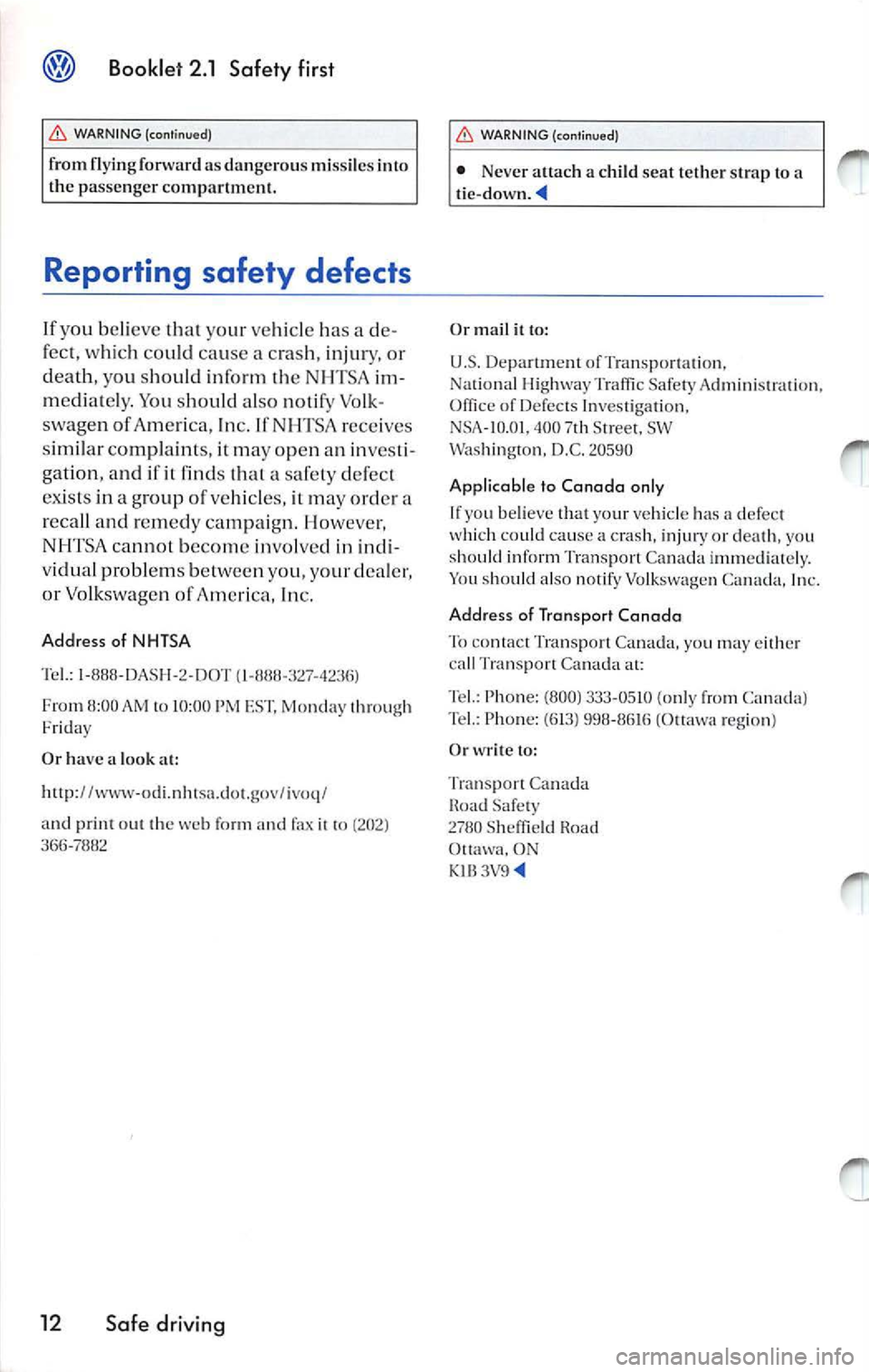
Booklet 2.1 Safety fir st
WARN ING (continu ed)
fro m fl ying fonvar cl as dan gerous miss iles into
th e passe nge r co mp artmen t.
Reporting safety defects
If you believe tha t vehicl e has a de
f ec t, w hic h co uld ca use a cra sh, in jury, or
d eath , you sh ould info rm th e NHTSA im
m edia te ly . Yo u sh oul d als o no tif y Volk
sw agen of Am erica , Inc. If N HT SA recei ves
s imi lar com plaint s, it m ay open an inves ti
gat ion , and i f it find s th at a saf ety defec t
exists in a grou p of ve hicl es, it m ay ord er a
reca ll an d re m ed y c am paig n. How ever,
N HTSA can not becom e in vo lve d in ind i
v idu al proble ms between you, you r d ea ler ,
or Vo lkswag en of A me rica, In c.
Addr ess of N HT SA
T e l.: l -888-DAS H-2- DOT
Fro m 8:00 AM to 10 :00 Mo nday through
Friday
O r ha ve a look a t:
http :// www-o cli.nht sa.cl ot.gov /ivu q/
and print out th e
form and it to (202)
366-7882
12 Safe driving
WARN ING (con tinued)
• Never att ac h a c hild seat teth er strap to a
O r m ail it to:
U.S. Depa rtm ent of Transporta tion ,
N ati onal H ig hway
Safe ty A dmini stra tio n. of Defects Invest ig ation .
NSA- l0.01, 400 7 th Str eet, SW
Wa sh ington, D.C. 20590
A ppli cabl e to Canada onl y
If yo u beli eve that yo ur veh icle has
d efec t
w hich cou ld ca use a crash, injur y or dea th , you
s h ould inform Transport Canada imm ediately.
Yo u sh oul d also notif y Volksw age n Canada, In c.
A ddress of Tran sp ort Cana da
To conta ct Transpo rt Cana da, yo u ma y either
ca ll Transport Ca nada at:
Tel.: Phone: (800 ) 333-05[0 (o nly fro m Can ada)
Tel.: Pho ne: (613) 998-86 16 (O ttawa reg io n )
O r wr ite to:
Transport Canada R oad Safe ty
2780
R oad
Ottawa. ON
Page 136 of 477
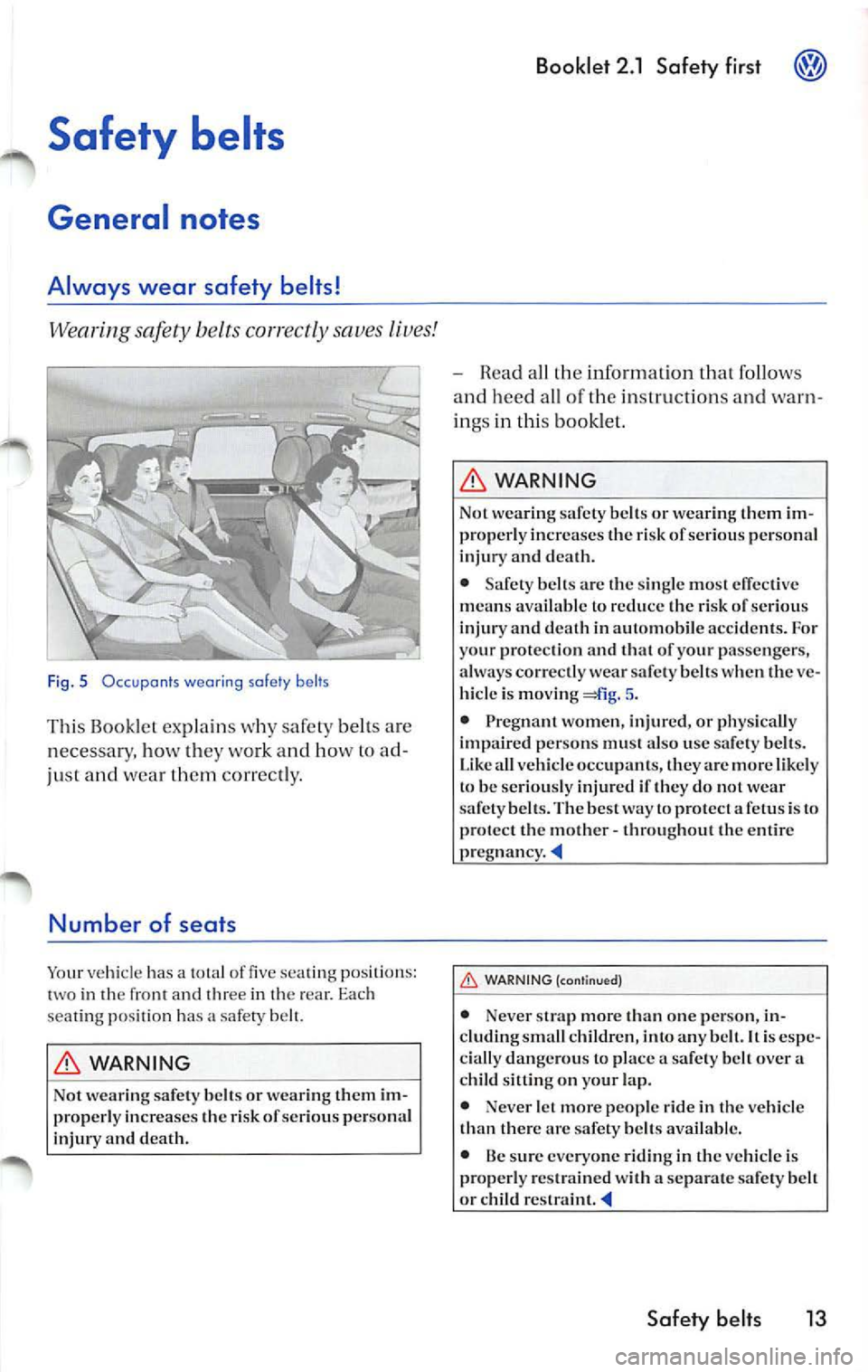
Safety belts
General not es
Always wear safety belts!
Wearing safety b elt s correctly saves lives!
Fig . 5 Occ upan ts wear ing safety belts
This Bookl et explain s why safet y belt s are
nece ssary, ho w the y work and how to ad
ju st and wear them correc tly.
Number of seats
Yo ur vehicl e has a tota l of five se ating position s: in the fro nt and three in th e rear. Each
sea tin g p ositio n ha s a sa fety b elt.
WARNING
Not wearing safety belts or wearing them im
properly increases the risk of seriou s per sona l
injury and d eat h.
Booklet 2.1 Safety first
- Read all the information th at follows
and heed all of th e in struction s and warn
in gs in thi s booklet.
WARNING
Not wearing safety belts or wearing them im
properly increases the risk of seriou s personal
injury and death.
• Safety belts are t he sin gle mo st efTec tive
means available to reduce the risk of se rious
injur y and death in automobile accidents.
your protection and that of your passengers,
a lwa ys corre ctl y wear safety belts when the ve
hicle is moving =;fig. 5.
• Pregnant women, injured, or physically
impaired per sons mu st
use safe ty belts.
l..ik eall vehicle occupant s, they arc more likely
to be seriou sly injur ed if the y do not wear
safety bel ts. The best way to protect
fet us is to
protect the mother -throughout the entire
pregnancy.
WAR NING (con tinued)
• Never strap more than one person, in
cluding small children, into any belt. It is espe
cially dangerous to pla ce a sa fety belt over a
c hild sittin g on yo ur lap.
• Never let more people ride in the vehicle
than ther e arc safe ty belt s available.
• Be sure eve ryone riding in the vehicle is
properly res train ed with a separat e safety belt
or child restraint.
Safety belts 13
Page 137 of 477
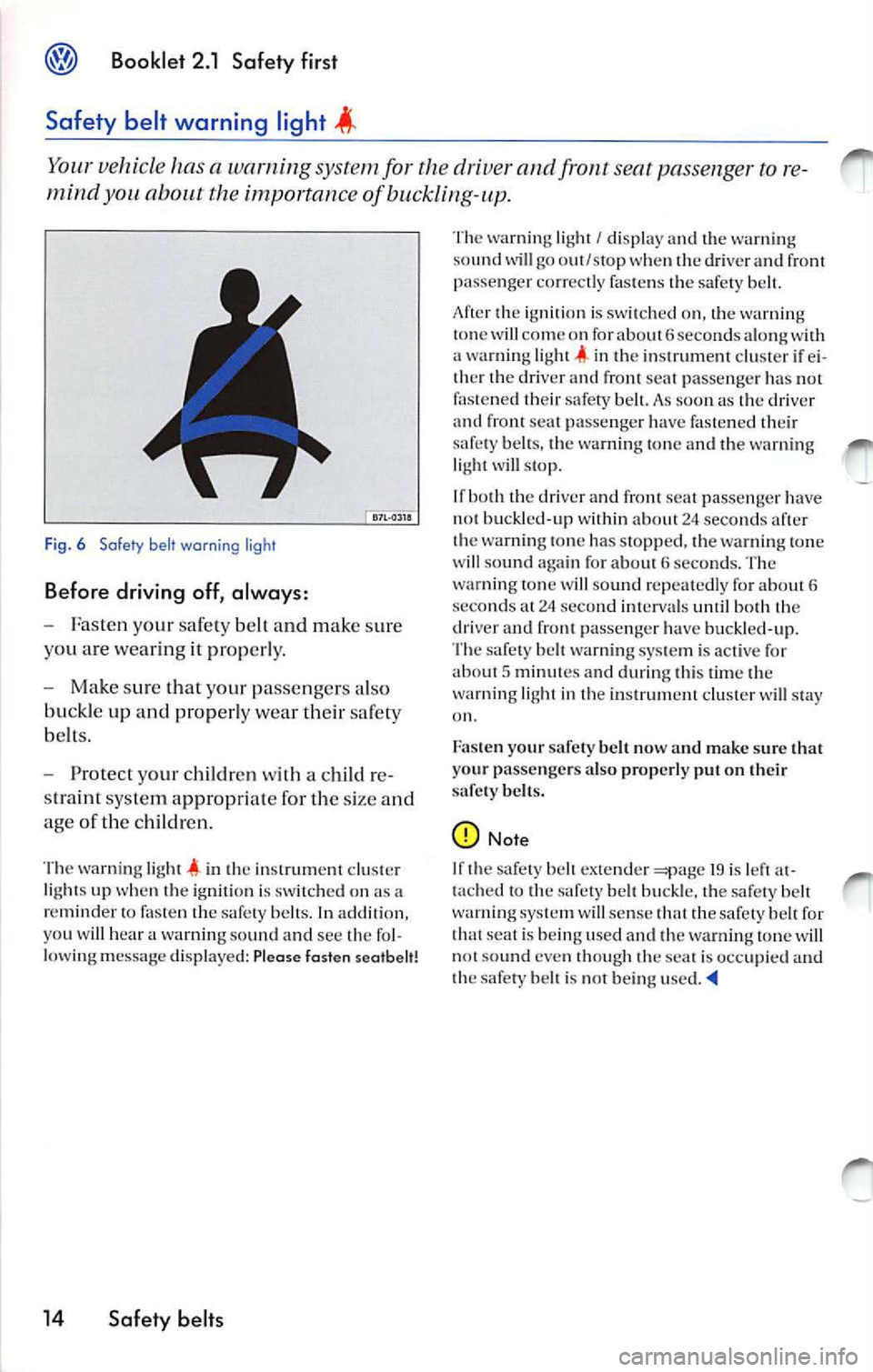
Booklet 2.1 Safety first
Safety belt warning light
Your vehicl e ha s a w arning s yste m for the driv er and front seat pa sseng er to r e
mind
about the importan ce of bucklin g-up.
Fig. 6 Safety bel t warn ing lig ht
B efore driving off, always :
Faste n you r safet y be lt and mak e sure
you are w ear ing it prop erl y.
Ma ke s ure th at your p asse nge rs als o
bu ckle up and proper ly w ear their sa fe ty
b elt s.
Prot ect yo ur chi ldr en with a c hild re
s traint sy ste m appropri ate fo r th e s ize and
ag e o f the ch ildren.
The wa rning lig ht in th e in strum ent cluste r
li g ht s up when t he ig nition is s wit ch ed on a s a
r e minder
to fa ste n th e sa fe ty belts. In addition ,
y o u w ill hear a warnin g so und and see th e fol
l ow ing m ess age displa yed: Please fasten s eatbelt!
14 Safety belts
The warnin g light I di spla y and th e warn ing
so un d w ill go o ut/stop w hen th e dri ver an d front
p asse nger co rrec tly faste n s th e s afety be lt.
the ig ni tio n i s sw itch ed on , th e warning
t o ne w ill co me o n fo r a bou t 6sec ond s alo n g wi th
a wa rnin g ligh t
in the in strum ent clu ste r if ei
th er th e dri ver and front sea t pa ssenge r ha s not
fa ste ned th eir saf ety belt. As s oon as th e dri ver
and front seat pa sse nger have fa ste n ed th eir
sa fe ty belts, the warnin g to ne and the wa rning
li g ht
sto p.
If both the dr iver and fron t se at pa sse nger h ave
no t buc kled- up w ithi n abou t
24 sec onds afte r
t h e wa rning to ne ha s s to pp ed, the w arn ing ton e
w ill soun d a gain for ab out 6 second s. Th e
w arnin g to n e w ill sound re peate dl y fo r ab out
6 sec ond s at 24 seco nd int erv als unt il bo th the
dri ver and fr ont p asse nge r have buckl ed-up.
Th e sa fety belt warnin g sys te m is ac tive for
a bo ut
5 minut es and durin g thi s tim e th e
w arn ing lig ht in th e in strum ent clu ste r w ill sta y
o n.
F as te n you r sa fe ty be lt now and make sure that
y our passenge rs als o proper ly p ut on their
safe ty be lts.
19 is le ft at
ta ch ed to th e sa fe ty belt bu ck le, th e s afe ty bel t
w arn ing sys te m will se nse that th e safety belt for
th at sea t is bein g use d and the w arnin g to ne w ill
n ot sound even th ou gh th e sea t is occ upi ed and
t h e safe ty belt is not b ein g use d.
Page 138 of 477
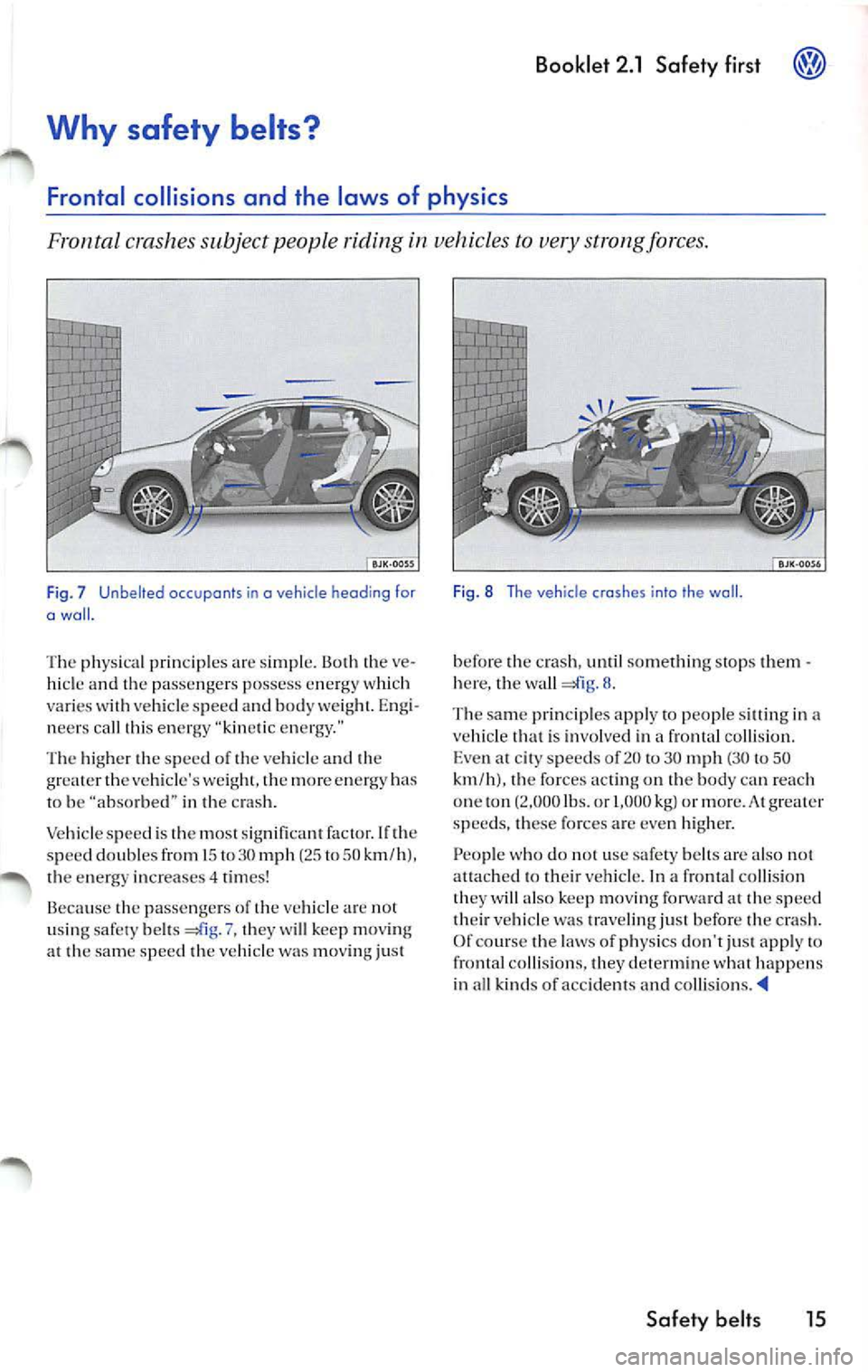
Booklet 2 .1 Safety fir st ®
Why safety belts?
Frontal collisions and the laws of physics
Fronta l crashe s subject people riding in vehicles to very strong force s.
F ig . 7 Unbelted occupants in a veh icle head ing for
o wal l.
The ph ysica l prin ciples ar e simpl e. Both th e hicle and th e pa sse nger s po ssess e nergy w hich
va ries with veh icl e s pee d and bod y weig ht. Engi
n eer s c all thi s en erg y " kin etic energy. "
The hi gher th e s pee d of the vehicl e and th e
gr eater t he v ehicl e's weight, th e more energy h as
to be "a b so rbed " in th e c rash .
V ehicle speed is th e m os t signifi cant factor. I f the
spe ed doubl es from 15 to 30 mph (25 to 50 km /h ),
th e e nerg y in crea ses 4 tim es !
Be ca u se th e pass eng ers of th e vehicle a re not
u sin g s afety belt s
7, th ey w ill kee p movin g th e s am e s pee d th e ve h icl e mo ving ju st
F ig . 8 The vehicle crashes into the wall.
before th e c ras h, un til somet hing stop s them h ere, t he wa ll 8.
T he s ame princip les a pply
people sit ting ve hicle tha t is in vol ve d in a frontal collision.
E ve n at spe ed s o f20 t o 30 mph (30 to 50
km /h ). t he forc es act in g on the bod y reach
on e ton (2,000 lbs. or l,000 kg) or more. Al greater
s pe ed s, these force s are ev en high er.
P eo ple wh o do not u se sa fety belt s arc al so nut
a tta ch ed to th eir ve hicl e. In a fronta l colli sion
t h ey will als o ke ep moving forwa rd a t th e sp ee d
th eir ve hicl e was tra ve lin g ju st befo re the crash.
Of cour se the law s of p hys ics don't ju st a pp ly to
fro ntal colli sion s, the y det ermine what happ en s
in all kind s of accident s
Safety belts 15
Page 139 of 477
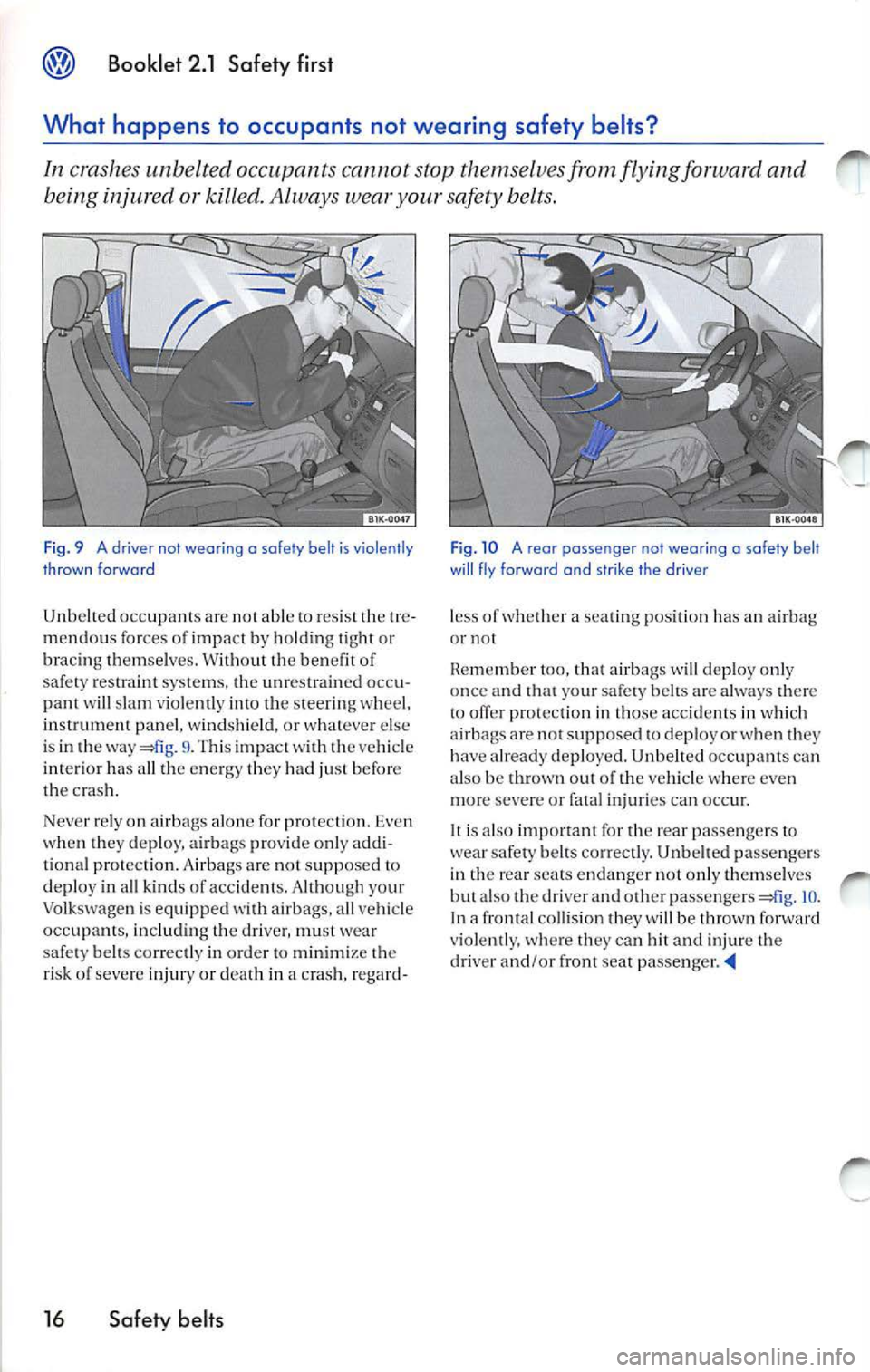
Booklet 2.1 Safety first
What happens to occupants not wearing safety belts?
In crashes unbelted occupant s cannot stop themselve s from flying forward and
being injured or killed. Always wear your safety belts.
Fig. 9 A driver not wearing o safety belt is violently
thrown forward
Un belted occ upants ar e not abl e to res ist the tre
m endo us fo rces o f imp act by holdin g tig ht or
bra cing themse lves . W ith ou t th e ben efit of
s af etv res traint systems. th e unr estrai ned o ccu
slam vio le ntl y into t he steering wheel,
in strnm ent panel, win dshi eld , o r w hate ve r else
is in the way
9. T his impac t w ith the ve hicle
inte rior has a ll th e e nergy the y had just before
the cras h.
Neve r re ly on airb ags alone for pro tec tion. Eve n
wh en th ey deplo y, air ba gs provide onl y a ddi
t io n al prot ection. Airb ags are not su pposed
depl oy in all kin ds of a cci den ts. Alt hough your
Volk swag en i s eq uipped with airbags, all vehicl e
occ upant s, inclu ding th e dr ive r, mu st wear
sa fety belt s co rrectl y in order to min imize th e
ri sk of seve re injur y or d eath in a cras h, regard-
16 Safety belts
Fig . 10 A rear passenger not wearing o sa fety belt
will fly forward and strike the drive r
less of wheth er a se atin g pos ition has a n or no t
R em emb er too, that ai rbags w ill dep loy o nly
once a nd t hat your sa fery be lts are always there
to offe r pro tec tion in th ose acci dent s in whi ch
a irba gs are not supp osed to dep loy o r w hen they
h ave already deployed. Unbelt ed occ upan ts can
a lso be thro wn out of th e ve hicle w here e ven
more severe or fa ta l in jur ies can occur.
I t i s a lso important for the rear passe ngers to
wea r sa fety belts correct ly. Unb elt ed pas se nge rs
in th e re ar sea ts endanger no t on ly th emse lves
b u t a ls o th e driver an d oth er pa ssenge rs
JO .
In a fron tal collisio n th ey w ill be thrown forward
v io len tly, whe re they ca n hi t a nd injure the
driver and /or front seat
Page 140 of 477
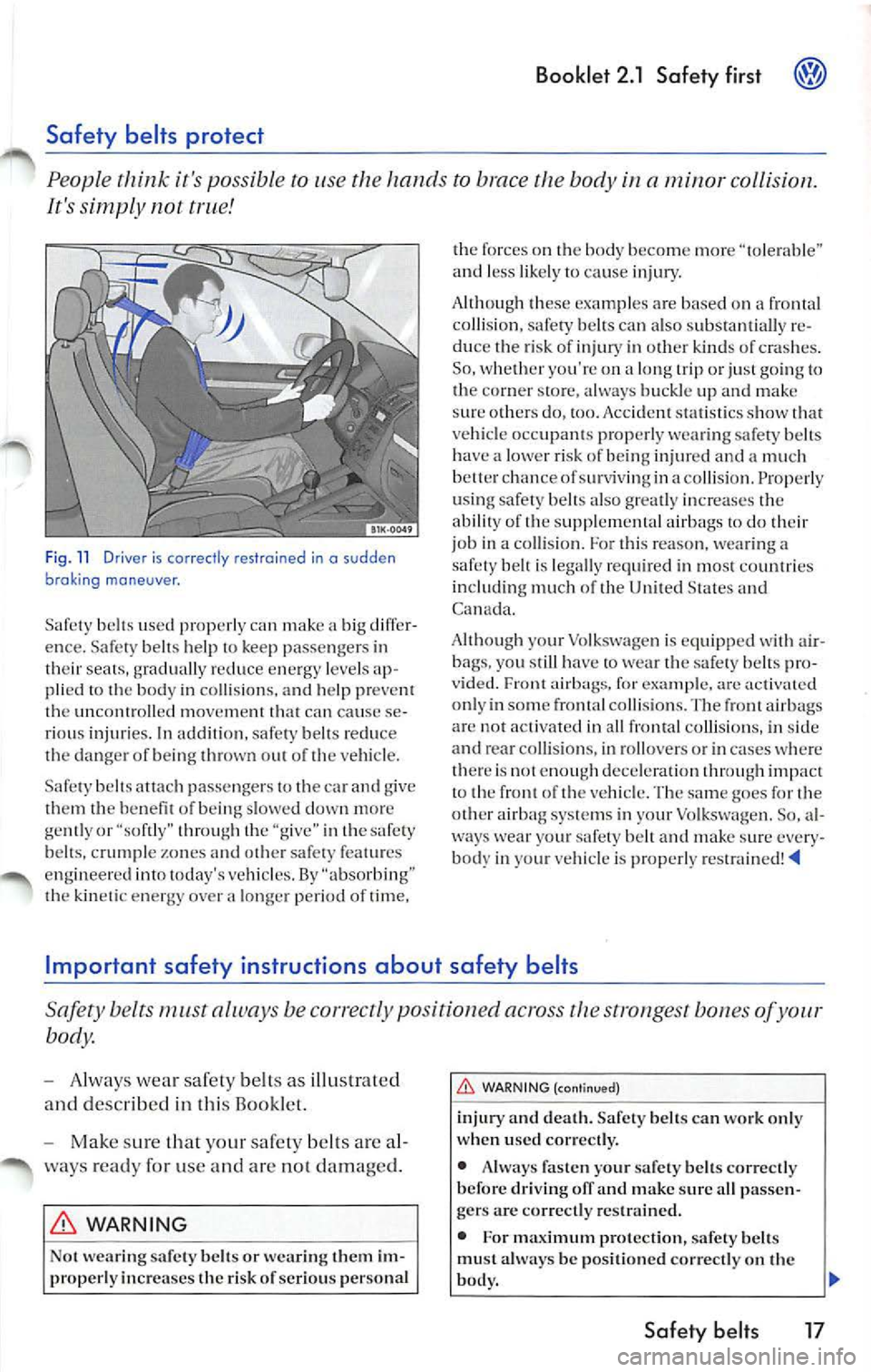
Booklet 2.1 Safety first
it 's po ssibl e to use the to brace the body a ,ninor collision.
It 's simp ly not
Fi g. 11 Driver is co rrectly re strained in o s udden
broki ng ma neuver .
Safely belt s used prop erl y can make a big diff er
ence. Safet y belts help to keep passe ngers in
the ir sea ls , gra dually r edu ce e nergy levels ap
pli ed
to the body in co llision s. and help preve nt
th e unc ontroll ed mo veme nl tha t can cause se
riou s injur ies. In ad di1i on, safe ty belt s redu ce
th e clang er of being thro wn ou1 o f th e ve hicl e.
Safe ty belt s atta ch passengers 10 the car and giv e
th em t he ben efi t of b eing
down more
ge nll yor "sof tly" through lhe "g ive" in the saf ety
b e lts, cru mp le zo ne s
other saf ely fea1 ures
e n gin ee re d into toda y's vehicl es. By "ab sorb ing"
t h e kinet ic ener gy ov er
longe r per iod of lime , th
e fo rces o n 1h e body be come more "tolerable "
and less likely to c ause injur y.
A lthoug h 1hese exa mples are ba sed on a frontal
co llision,
belt s can also sub sla nt ially re
duc e the risk of inju ry in 01h er kin ds of crash es.
So . w heth er yo u're on a long 1rip or ju sl go ing to
lh e c orner stor e, always buckle up and make
s ur e oth ers do, too. Acci denl statist ics sh ow 1h at
ve hicle occ upan 1s prop erl y wea ring sa fe ty
ha ve lower risk of bein g in jur ed and a much
b elie r ch an ce of in collis io n. Properl y
u sin g safe ty bell s also great ly in cre a ses the
abili 1y of 1 he s uppl em ent al a irbags 10 do their
job in a collisio n . Fo r thi s rea son, wea ring a
safe ty belt is lega lly re quir ed in mo sl cou ntries
includin g mu ch of th e Un ited
and
Canada .
A lth ough your Volk swage n i s eq uipped wilh a ir
ba gs. yo u still have to we ar th e safe ly be lts pro
v id ed. Fro nt a irba gs, for examp le,
a cti va ted
on ly in some frontal collisio ns. Th e front airb ags
a re no t acli vated in all fron ta l co lli sio ns, in sid e
and rea r co llisio ns. in rollo vers o r in cas es wh ere
is no t e nou gh de celeration through impac t
to the front of the vehicle. Th e sa me go es for the
01 hcr airbag sys1ems in yo ur Volk sw agen. So, al
w ays
you r saf ety belt and mak e sure ev ery
bo dy in ve hicle is prop erly
Impo rtant safety instructions about safety belts
Safety bel ts must alway s be cor rect ly pos i ri on ed across the strongest bones of you r
body.
- Always wea r saf ety bells as ill ustra ted
and descr ibed in thi s Bookl et.
- Make su re th at yo ur sa fet y be lts a rc a l
ways rea dy fo r u se and arc no t da ma ged.
WARNING
Not wea ring sa fe ty belt s or wearing t hem im
prop erl y inc re as es the ri sk of se rious per sona l
WAR NING (continued)
injury and death. Safety belts ca n w ork onl y
w hen u sed correct ly.
• Always fas te n yo ur safety belt s cor rect ly
before dri vin g o ff and make sure all pa sse n
ge rs are cor rec tly res tra in ed.
•
m ax imum protection, sa fel y belt s
mu st be po sitione d cor rectly on th e
body.
Safety belts 17